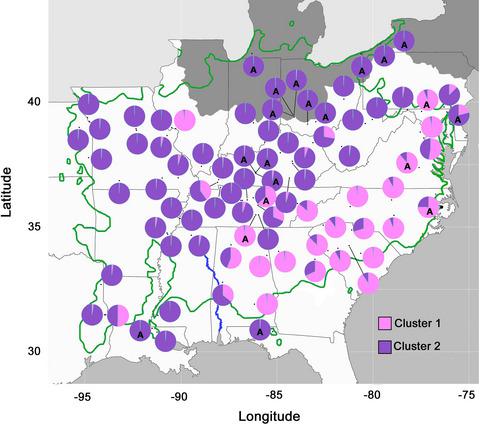当前位置:
X-MOL 学术
›
Ecol. Evol.
›
论文详情
Our official English website, www.x-mol.net, welcomes your
feedback! (Note: you will need to create a separate account there.)
The role of anthropogenic dispersal in shaping the distribution and genetic composition of a widespread North American tree species
Ecology and Evolution ( IF 2.3 ) Pub Date : 2021-07-30 , DOI: 10.1002/ece3.7944 Graham E Wyatt 1 , J L Hamrick 1 , Dorset W Trapnell 1
Ecology and Evolution ( IF 2.3 ) Pub Date : 2021-07-30 , DOI: 10.1002/ece3.7944 Graham E Wyatt 1 , J L Hamrick 1 , Dorset W Trapnell 1
Affiliation

|
Dispersal and colonization are among the most important ecological processes for species persistence as they allow species to track changing environmental conditions. During the last glacial maximum (LGM), many cold-intolerant Northern Hemisphere plants retreated to southern glacial refugia. During subsequent warming periods, these species expanded their ranges northward. Interestingly, some tree species with limited seed dispersal migrated considerable distances after the LGM ~19,000 years before present (YBP). It has been hypothesized that indigenous peoples may have dispersed valued species, in some cases beyond the southern limits of the Laurentide Ice Sheet. To investigate this question, we employed a molecular genetics approach on a widespread North American understory tree species whose fruit was valued by indigenous peoples. Twenty putative anthropogenic (near pre-Columbian habitations) and 62 wild populations of Asimina triloba (pawpaw), which produces the largest edible fruit of any North American tree, were genetically assayed with nine microsatellite loci. Putative anthropogenic populations were characterized by reduced genetic diversity and greater excess heterozygosity relative to wild populations. Anthropogenic populations in regions that were glaciated during the LGM had profiles consistent with founder effects and reduced gene flow, and shared rare alleles with wild populations hundreds of kilometers away (mean = 723 km). Some of the most compelling evidence for human-mediated dispersal is that putative anthropogenic and wild populations sharing rare alleles were separated by significantly greater distances (mean = 695 km) than wild populations sharing rare alleles (mean = 607 km; p = .014). Collectively, the genetic data suggest that long-distance dispersal played an important role in the distribution of pawpaw and is consistent with the hypothesized role of indigenous peoples.
中文翻译:

人为扩散在塑造北美广泛树种的分布和遗传组成中的作用
扩散和定殖是物种持久性最重要的生态过程之一,因为它们使物种能够跟踪不断变化的环境条件。在末次盛冰期(LGM)期间,许多不耐寒冷的北半球植物撤退到南冰期避难所。在随后的变暖时期,这些物种将其活动范围向北扩展。有趣的是,一些种子传播有限的树种在距今约 19,000 年的末次盛宴之后迁移了相当长的距离(YBP)。据推测,土著人民可能已经传播了有价值的物种,在某些情况下,传播到了劳伦泰德冰原南部界限之外。为了研究这个问题,我们对一种广泛分布的北美林下树种采用了分子遗传学方法,该树种的果实受到土著人民的重视。对 20 个假定的人为种群(靠近前哥伦布时期的居住地)和 62 个野生阿西米娜三叶树(木瓜)种群进行了九个微卫星位点的基因分析,木瓜是北美树木中最大的可食用果实。与野生种群相比,假定的人类种群的特征是遗传多样性减少和过度杂合性更大。末次盛冰期冰川作用地区的人类种群具有与奠基者效应一致的特征,并且基因流减少,并且与数百公里外的野生种群共享稀有等位基因(平均值 = 723 公里)。关于人类介导的传播的一些最令人信服的证据是,假定的共享稀有等位基因的人类和野生种群之间的距离(平均值 = 695 公里)明显大于共享稀有等位基因的野生种群(平均值 = 607 公里;p = .014 ) 。总的来说,遗传数据表明长距离传播在木瓜的分布中发挥了重要作用,并且与土著人民的假设作用一致。
更新日期:2021-08-16
中文翻译:

人为扩散在塑造北美广泛树种的分布和遗传组成中的作用
扩散和定殖是物种持久性最重要的生态过程之一,因为它们使物种能够跟踪不断变化的环境条件。在末次盛冰期(LGM)期间,许多不耐寒冷的北半球植物撤退到南冰期避难所。在随后的变暖时期,这些物种将其活动范围向北扩展。有趣的是,一些种子传播有限的树种在距今约 19,000 年的末次盛宴之后迁移了相当长的距离(YBP)。据推测,土著人民可能已经传播了有价值的物种,在某些情况下,传播到了劳伦泰德冰原南部界限之外。为了研究这个问题,我们对一种广泛分布的北美林下树种采用了分子遗传学方法,该树种的果实受到土著人民的重视。对 20 个假定的人为种群(靠近前哥伦布时期的居住地)和 62 个野生阿西米娜三叶树(木瓜)种群进行了九个微卫星位点的基因分析,木瓜是北美树木中最大的可食用果实。与野生种群相比,假定的人类种群的特征是遗传多样性减少和过度杂合性更大。末次盛冰期冰川作用地区的人类种群具有与奠基者效应一致的特征,并且基因流减少,并且与数百公里外的野生种群共享稀有等位基因(平均值 = 723 公里)。关于人类介导的传播的一些最令人信服的证据是,假定的共享稀有等位基因的人类和野生种群之间的距离(平均值 = 695 公里)明显大于共享稀有等位基因的野生种群(平均值 = 607 公里;p = .014 ) 。总的来说,遗传数据表明长距离传播在木瓜的分布中发挥了重要作用,并且与土著人民的假设作用一致。











































 京公网安备 11010802027423号
京公网安备 11010802027423号